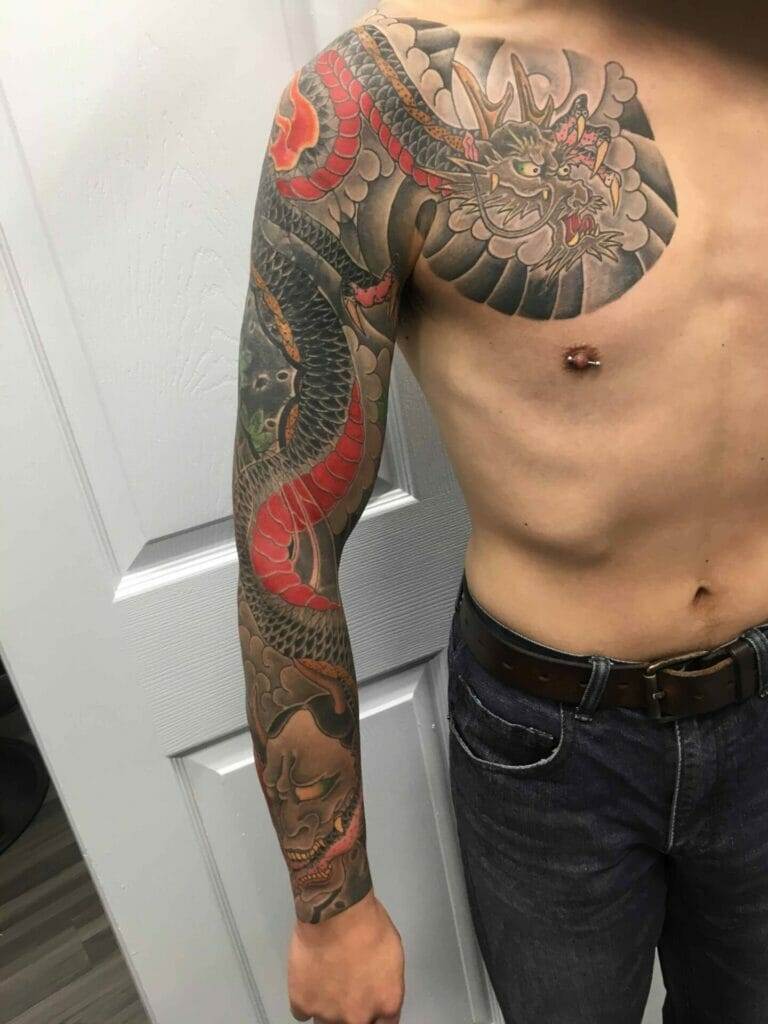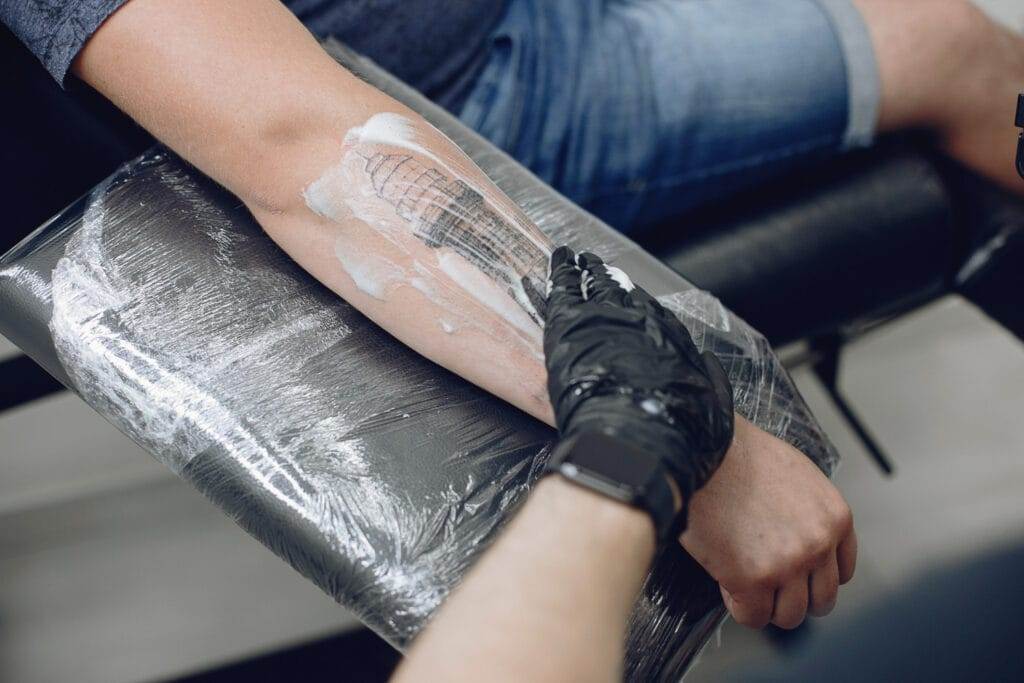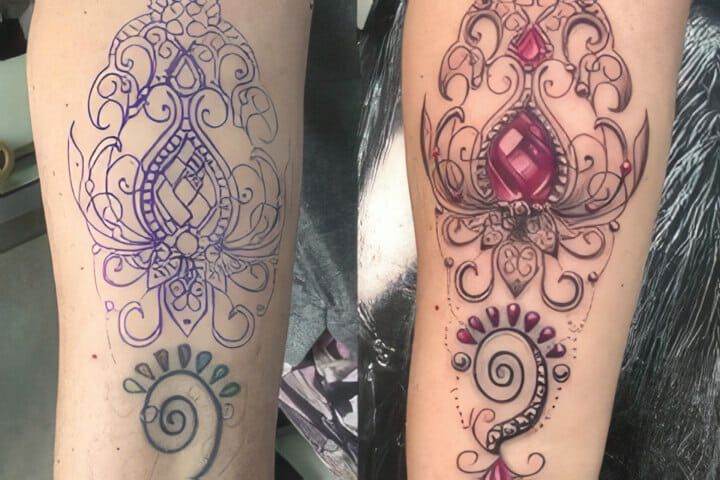Cover-Up Tattoos: A New Beginning
Many people find themselves regretting their tattoos for various reasons. Whether it’s a change in personal taste, a desire to remove a reminder of a past relationship, or a need to conform to professional standards, the solution for these individuals lies in the innovative technique of cover-up tattoos. Cover-up tattoos involve creating a new design over an existing tattoo, effectively hiding it and giving the wearer a fresh start.
The Evolution of Cover-Up Tattoos
Over the years, the art of cover-up tattoos has evolved significantly, giving tattoo artists the ability to transform unwanted tattoos into beautiful works of art. Here is a comparison between traditional cover-up techniques and the modern advancements in this field:
Traditional Techniques | Modern advancements
- Layering: In the past, artists would use a layering technique to cover up unwanted tattoos. This involved applying multiple layers of darker ink on top of the existing tattoos to create a new design. However, this method often resulted in bulky and heavy-looking cover-up tattoos.
- Laser Tattoo Removal: With the advent of laser tattoo removal technology, artists now have the option to fade the existing tattoo before proceeding with a cover-up. This allows for greater flexibility in design options and ensures the best possible outcome.
- Color Palette: In the past, cover-up tattoos were often limited to darker colors to effectively hide the underlying tattoo. However, modern advancements in tattoo pigments have expanded the color palette, allowing for more creative and vibrant cover-up designs.
- Custom Designs: In the past, cover-up options were limited to what could be achieved by modifying the existing tattoo. Nowadays, artists can create custom designs specifically tailored to cover-up tattoos, ensuring that the new tattoo seamlessly integrates into the wearer’s body art collection.
Cover-up tattoos offer individuals a chance to move on from their unwanted tattoos and embrace a new beginning. With the evolution of cover-up techniques, the possibilities are endless, giving people the opportunity to turn their tattoo regrets into a beautiful work of art.
Understanding Cover-Up Tattoos

What are Cover-Up Tattoos?
Cover-up tattoos are a popular solution for those who regret their tattoos and are looking for a fresh start. This innovative technique involves creating a new design over an existing tattoo, effectively hiding it. Whether it’s a change in personal taste, the need to remove a reminder of a past relationship, or the desire to conform to professional standards, cover-up tattoos offer individuals the opportunity to transform their unwanted tattoos into a beautiful work of art.
Factors to Consider Before Getting a Cover-Up Tattoo
Before getting a cover-up tattoo, there are a few important factors to consider:
- Existing Tattoo: The size, color, and location of the existing tattoo will play a significant role in determining the feasibility of a cover-up. Darker and larger tattoos may require more intricate designs to effectively hide them.
- Tattoo Artist: It is crucial to find an experienced tattoo artist who specializes in cover-up tattoos. They will have the skills and knowledge to assess the existing tattoo and create a design that seamlessly integrates with the wearer’s body art collection.
- Design Options: With modern advancements in tattoo pigments, cover-up tattoos are no longer limited to dark colors. The expanded color palette allows for more creative and vibrant designs, giving individuals the freedom to choose a design that truly reflects their personal style.
- Laser Tattoo Removal: In some cases, laser tattoo removal may be a necessary step before proceeding with a cover-up. Fading the existing tattoo with laser technology allows for more flexibility in design options and ensures the best possible outcome.
In conclusion, cover-up tattoos offer individuals a chance to move on from their unwanted tattoos and embrace a new beginning. By understanding the concept and considering important factors, individuals can make informed decisions about getting a cover-up tattoo. With the evolution of cover-up techniques, there are endless possibilities to turn tattoo regrets into a beautiful work of art.
The Cover-Up Process
Steps in the Cover-Up Tattoo Process
A cover-up tattoo involves several steps to effectively hide an existing tattoo:
- Consultation: The first step is to consult with an experienced tattoo artist who specializes in cover-up tattoos. During this consultation, the artist will assess the existing tattoo and discuss design options with the individual.
- Design Planning: Once the artist has a clear understanding of the individual’s vision and the existing tattoo, they will create a custom design that incorporates the cover-up elements. The design may include elements that strategically blend with or disguise the old tattoo.
- Tattooing Process: With the design finalized, the tattoo artist will begin the cover-up process. They will use suitable colors and techniques to effectively conceal the old tattoo while creating a new, aesthetically pleasing design.
- Touch-Ups: Depending on the complexity of the cover-up and the individual’s skin healing process, touch-ups may be required. This ensures that the cover-up is seamless and the old tattoo remains hidden.
Strategies for Successfully Concealing Unwanted Ink
Successfully concealing unwanted ink requires careful planning and attention to detail. Here are some strategies that tattoo artists use:
- Design Integration: The new design should seamlessly integrate with the surrounding body art. This can be achieved by incorporating elements from the existing tattoo or using complementary colors and patterns.
- Color Choice: The tattoo artist will carefully select colors that effectively hide the old tattoo. This may involve using darker shades or strategic shading techniques to minimize the visibility of the previous ink.
- Placement Considerations: The placement of the cover-up tattoo is crucial in concealing the old tattoo. Skilled artists will consider the size, shape, and location of the existing tattoo to create a design that effectively hides it.
Overall, cover-up tattoos provide individuals with an opportunity to transform their unwanted tattoos into new, meaningful designs. By following the cover-up process and incorporating effective strategies, tattoo artists can help individuals move on from their tattoo regrets and embrace a fresh start.
Choosing the Right Design
Design Options for Cover-Up Tattoos
A cover-up tattoo involves a careful and thoughtful design process to effectively hide an existing tattoo. The following are some design options that individuals can consider:
- Transformation: One option is to transform the existing tattoo into a completely new design. This can involve incorporating the old tattoo into a larger, more intricate design that effectively disguises it.
- Overlay: Another option is to create a design that overlays and incorporates elements from the old tattoo. This can be done by adding new details, colors, or patterns to create a cohesive and visually appealing cover-up.
- Disguise: Some individuals may prefer to completely disguise the old tattoo by creating a design that does not incorporate any elements of the previous ink. This can include choosing a different subject matter or style that effectively conceals the unwanted tattoo.
Considering Placement and Size for Effective Cover-Ups
When planning a cover-up tattoo, the placement and size of the new design are crucial factors to consider. Here are some considerations for achieving an effective cover-up:
- Size: The size of the new tattoo should be large enough to adequately cover the existing tattoo. The tattoo artist will assess the size of the old tattoo and recommend an appropriate size for the cover-up.
- Placement: The location of the cover-up tattoo plays a significant role in effectively hiding the old tattoo. The artist will consider factors such as the shape, size, and color of the existing tattoo to determine the best placement for the new design.
- Integration: The new design should seamlessly integrate with the surrounding body art. This can be achieved by incorporating elements from the existing tattoo or using complementary colors and patterns.
Successfully concealing an unwanted tattoo through a cover-up requires careful consideration of design options, placement, and size. By working closely with a skilled tattoo artist, individuals can transform their regrets into a fresh start with a new, meaningful design.
Tattoo Removal Options

Exploring Tattoo Removal Methods
Individuals who are looking to cover up an unwanted tattoo may consider tattoo removal as an option. There are several methods available for removing tattoos, including:
- Laser Removal: This is the most popular and effective method. It involves using laser technology to break down the tattoo ink particles, allowing the body to naturally eliminate them over time. Multiple sessions may be required to achieve the desired results.
- Dermabrasion: This method involves using a high-speed rotary device to sand down the outer layers of the skin, effectively removing the tattoo ink. It can be a painful process and may require multiple sessions for complete removal.
- Surgical Excision: In some cases, the tattoo can be surgically cut out and the remaining skin stitched together. This method is typically used for smaller tattoos and may result in scarring.
- Chemical Peels: This method involves applying a solution to the skin that causes the top layers to peel off, taking the tattoo ink with them. It is not as effective as laser removal and may require multiple treatments.
When Tattoo Removal is Necessary for Cover-Up
In some cases, tattoo removal may be necessary before getting a cover-up tattoo. This is particularly true when:
- The tattoo is too dark or heavily saturated: Dark and heavily inked tattoos can be challenging to cover up successfully. Fading the tattoo through removal treatments can make it easier to design a cover-up that effectively hides the old tattoo.
- The tattoo design is incompatible with the desired cover-up: If the existing tattoo design clashes with the new design concept, removing the old tattoo may be necessary to ensure a cohesive and visually appealing result.
- The size of the old tattoo is too large: Covering up a large tattoo with a significantly smaller design may not yield satisfactory results. Removing the old tattoo can allow for more flexibility in choosing the size and placement of the new design.
Overall, tattoo removal can be a viable option for individuals looking to get a cover-up tattoo. Consulting with a professional tattoo artist and a dermatologist can help determine the best course of action based on the specific tattoo and desired cover-up design.



